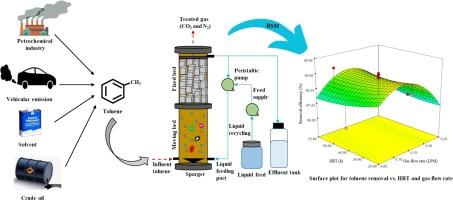在缺氧混合生物反应器中处理气态甲苯:利用响应面方法进行优化
Q1 Environmental Science
Environmental Nanotechnology, Monitoring and Management
Pub Date : 2024-09-19
DOI:10.1016/j.enmm.2024.101006
引用次数: 0
摘要
本研究的重点是利用缺氧混合生物反应器(AnHBR)处理化工和石化工业排放的气态甲苯,并利用响应面方法(RSM)优化工艺。通过改变甲苯的气体流速(0.05-0.25 LPM),AnHBR 中的气体停留时间(GRT)从 0.53 到 2.67 h 不等,从而使入口装载率(ILR)从 0.36 到 14.33 g/m3 h 不等。通过改变操作参数来确定最佳组合,以实现最大的甲苯去除率,在整个操作过程中,甲苯去除率始终保持在 96% 以上。在 AnHBR 中的优化组合(流速:0.15 LPM,GRT:0.89 h,HRT:48 h)下,甲苯去除率达到 99%,生成的最终产品包括 1.8% 的 CO2 和 92.9% 的 N2 气体。元基因组学分析表明,甲苯降解剂占主导地位(38%),突出了它们在 AnHBR 中降解甲苯的潜力。RSM 增强了 AnHBR 中的甲苯处理能力,证明了其在处理高污染物负荷时的稳健性及其在工业应用中的潜力。本文章由计算机程序翻译,如有差异,请以英文原文为准。

Treatment of gaseous toluene in an anoxic hybrid bioreactor: Optimization using response surface methodology
This study focuses on treating gaseous toluene emissions from chemical and petrochemical industries using an anoxic hybrid bioreactor (AnHBR) and optimizing the process using response surface methodology (RSM). By varying the gas flow rate (0.05–0.25 LPM) of toluene, the gas residence time (GRT) within the AnHBR ranged from 0.53 to 2.67 h, resulting in an inlet loading rate (ILR) between 0.36 to 14.33 g/m3 h. Simultaneously, the hydraulic retention time (HRT) of the liquid feed was varied from 24 to 72 h in the AnHBR. The operating parameters were varied to determine the optimal combination to achieve the maximum toluene removal, which remained above 96% throughout the operation. At the optimized combinations (flow rate: 0.15 LPM, GRT: 0.89 h, and HRT: 48 h) in AnHBR, toluene removal reached ∼99%, with end products generated consisting of 1.8% CO2 and 92.9% N2 gas. Metagenomics analysis revealed a dominance of toluene degraders (∼38%), highlighting their potential to degrade toluene in the AnHBR. The RSM enhanced toluene treatment in the AnHBR, demonstrating robustness in handling high pollutant loads and its potential for industrial applications.
求助全文
通过发布文献求助,成功后即可免费获取论文全文。
去求助
来源期刊

Environmental Nanotechnology, Monitoring and Management
Environmental Science-Water Science and Technology
CiteScore
13.00
自引率
0.00%
发文量
132
审稿时长
48 days
期刊介绍:
Environmental Nanotechnology, Monitoring and Management is a journal devoted to the publication of peer reviewed original research on environmental nanotechnologies, monitoring studies and management for water, soil , waste and human health samples. Critical review articles, short communications and scientific policy briefs are also welcome. The journal will include all environmental matrices except air. Nanomaterials were suggested as efficient cost-effective and environmental friendly alternative to existing treatment materials, from the standpoints of both resource conservation and environmental remediation. The journal aims to receive papers in the field of nanotechnology covering; Developments of new nanosorbents for: •Groundwater, drinking water and wastewater treatment •Remediation of contaminated sites •Assessment of novel nanotechnologies including sustainability and life cycle implications Monitoring and Management papers should cover the fields of: •Novel analytical methods applied to environmental and health samples •Fate and transport of pollutants in the environment •Case studies covering environmental monitoring and public health •Water and soil prevention and legislation •Industrial and hazardous waste- legislation, characterisation, management practices, minimization, treatment and disposal •Environmental management and remediation
 求助内容:
求助内容: 应助结果提醒方式:
应助结果提醒方式:


